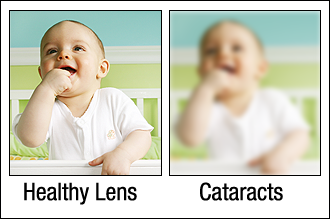More than half of Americans who are 80 and older have had cataracts. However, that doesn’t mean you should wait until then to start thinking about them.
Since nearly everyone will experience cataracts, it’s never too early to understand how they can affect you. That way, you can recognize signs of them and know you can treat them once you have them.
Keep reading to learn if you should start worrying about cataracts in your forties!
What is a Cataract?

Your lens is a part of your eye that focuses light. It is found behind your iris.
Usually, your lens is transparent. When you have a cataract, it becomes opaque and cloudy.
The severity of this cloudiness increases as the cataract continues to develop. As you age, proteins in your eye break down and form cloudy areas, making it more challenging to see clearly.
This is a natural part of the aging process. The breakdown of proteins is what causes cataracts.
Age-related cataracts are most common, but there are multiple types of cataracts. Although rare, infants can be born with cataracts or for them to develop one during childhood. Cataracts can also occur as a result of injury to the eye.
Cataracts usually develop in both eyes but may develop at different rates.
What are the Symptoms of a Cataract?

One of the most common complaints cataract patients have is that they feel like they are constantly looking through a foggy window. However, cataracts can affect your vision in more ways than one.
Symptoms that many patients experience include:
- Cloudy, blurry, or foggy vision
- Light sensitivity
- Faded or yellowed colors
- Glare or halos around light sources
- “Second sight,” where your vision temporarily improves but then worsens again
- Double vision in one eye
- Falling more often due to increasingly impaired vision
- Becoming unable to take part in favorite hobbies
- Noticing that colors look muddy or browner than they should
If you have cataracts, you may need to change your glasses or contact lenses prescription more frequently. In the early stages, an updated prescription can be enough to compensate for having a cataract.
However, as the cataract grows and develops, your current prescription becomes ineffective, making further changes necessary. Eventually, it will get to a point when making these changes will no longer help.
Similarly, you may need to turn on more lights when completing close-up tasks that require focus. Using more light can help if you have cataracts, but it will only do so much.
Impaired vision due to cataracts can have a far-reaching impact on your life. You can fall or injure yourself when you can’t see clearly. Ordinary activities like driving at night can also become dangerous to you and others on the road.
Cataracts can cause glare around streetlights or from oncoming traffic, making it unsafe to continue driving at night until you have cataract surgery.
When Do Cataracts Typically Form?

Cataracts can start developing as early as your forties or fifties. However, most people with cataracts do not realize it, at least initially.
Cataracts can start small and develop very slowly. It may be years or even decades before they affect your vision.
As the clouded area grows, it blocks more light from passing through your lens, eventually impairing your vision. Until it gets to that point, you may not notice any symptoms, or symptoms may be so mild that they don’t bother you.
This is one reason why regular exams with your eye doctor are critical. Only your eye doctor can identify early signs of a cataract that you may not notice yourself.
In addition to age, some factors are associated with an increased risk of developing cataracts. These include smoking, excessive alcohol consumption, having a family history of cataracts, spending lots of time in the sun, and certain health conditions and medications. Let your ophthalmologist know if you think you may be at an increased risk of developing cataracts.
How are Cataracts Treated?
While you should start thinking about cataracts in your forties, there’s no need to worry about whether you could develop them. You can effectively treat cataracts by having cataract surgery.
Even if you know you have cataracts, that doesn’t mean you must undergo surgery immediately. In most cases, your cataract surgeon will only recommend surgery once a cataract begins to have a significant impact on your life.

If you have to modify your everyday activities or avoid them altogether, it’s time to consider surgery. Are you no longer able to go hiking with your best friends because of your vision?
Does even making a simple meal in the kitchen prove to be too much? These are signs you should consider cataract surgery.
Cataract surgery is the only way to eliminate a cataract. When you have a cataract, it will not get better on its own, and symptoms will only worsen with time. Without surgery, if a cataract is bothering you now, your vision will only deteriorate further in the future.
Cataract surgery is a very common and safe outpatient procedure. It works by completely removing the cataract from your eye.
It accomplishes this by removing the lens where the cataract has formed. Your cataract surgeon will replace your natural lens with a clear, artificial one. With the cataract gone, your eye can focus light and create sharp images again.
The new artificial lens is called an intraocular lens, or IOL. The type of IOL you choose may allow you to see even better than before you had a cataract. There are many different kinds of IOLs available, including premium lenses. With a premium lens, you can reduce your dependence on glasses and contact lenses.
Are you worried you might have a cataract? Schedule an appointment at Dell Laser Consultants in Austin, TX, today! Isn’t it time to take charge of your vision?





